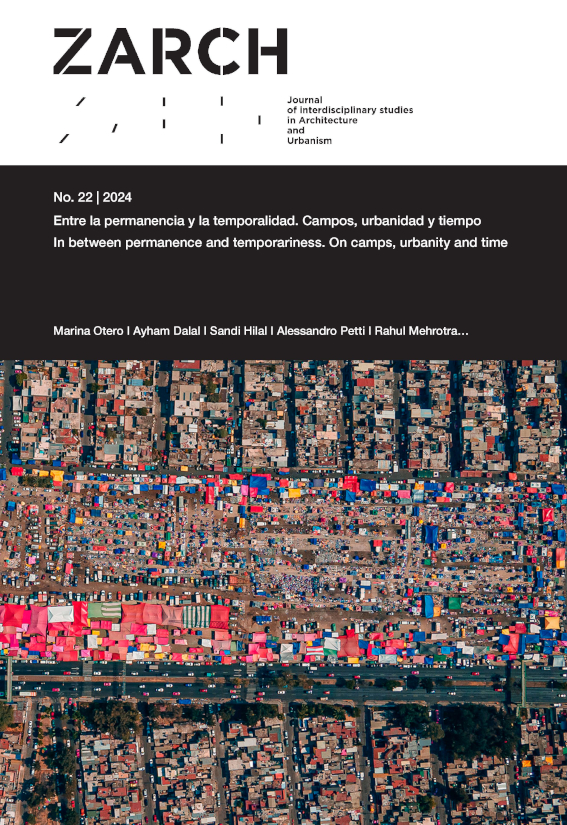Oblivions of New York. Temporality and memory it the heterotopic spaces of the urban fabric
DOI:
https://doi.org/10.26754/ojs_zarch/zarch.2024229898Keywords:
memory, Historical consciousness, temporality, New York, Creative destruction, heteropiaAbstract
Throughout the 19th century, the Commissioners' Plan of 1811 and the emerging forces of modernity established the groundwork for what could be termed the "permanent temporality" of New York City, positioning it as an ideal setting for exploring the relationship between memory and space. This quality, which places change and the “culture of congestion” as constants of the metropolis's urban fabric, provides lessons for the development of cities in the 21st century. Through Michel Foucault's concept of heterotopia, we can understand urban areas not only as scenes of physical and temporal transformations but as assemblies of “other spaces” that exist in parallel, challenging and complementing narratives of permanence over time.
Following also the urban theories of Henri Lefebvre, Richard Sennett, Susan Fainstein, and Rem Koolhaas, this article examines the role of some heterotopic spaces in New York that, filled with layers and meanings, redefine our perception of stability and temporality in the urban context. The intersections between real and heterotopic space thus reveal “oblivions” surpassed by historical becoming, underlining the importance of considering these spaces to negotiate the role of memory in future urban planning and development.
Downloads
References
Atack, Jeremy, y Robert A. Margo. "Location, Location, Location! The Price Gradient for Vacant Urban Land: New York, 1835 to 1900." The Journal of Real Estate Finance and Economics 16 (1998): 151–172.
Baics, Gergely, y Leah Meisterlin. “Zoning Before Zoning: Land Use and Density in Mid-Nineteenth-Century New York City.” Annals of the American Association of Geographers 106, no. 5 (2016): 1152-1175. https://doi.org/10.1080/24694452.2016.1177442
Ballon, Hilary, ed., The Greatest Grid: The Master Plan of Manhattan, 1811–2011. Nueva York: Columbia University Press, 2012.
Blackmar, Elizabeth. Manhattan for Rent, 1785-1850, 14-43. Ithaca, NY: Cornell University Press, 1989.
Callow, Philip. From Noon to Starry Night: A Life of Walt Whitman. Chicago: Ivan R. Dee, 1992.
Dehaene, Michiel y Lieven De Cauter, eds. Heterotopia and the City: Public Space in a Postcivil Society. Londres: Routledge, 2008
Fainstein, Susan. "Resilience and Justice." En The Post-Urban World: Emergent Transformation of Cities and Regions in the Innovative Global Economy, editado por Tigran Haas y Hans Westlund. Londres: Routledge, 2018.
Fishman, Robert, ed. The American Planning Tradition: Culture and Policy. Washington: The Woodrow Wilson Center Press, 2000.
Foucault, Michel. "Espacios diferentes." En Obras esenciales, Vol. iii, 431-441. Barcelona: Paidós, 1999.
Gibson, Campbell. “Population of the 100 Largest Cities and Other Urban Places in the United States: 1790 to 1990.” United States Census Bureau, junio de 1998. http://www.census.gov.
Hailey, Charlie. Camps: A Guide to 21st Century Space. Cambridge, MA: The MIT Press, 2009.
Heckscher, Morrison H. Creating Central Park. Nueva York: The Metropolitan Museum of Art, 2008.
Koolhaas, Rem. Delirio de Nueva York. Barcelona: Gustavo Gili, 2004.
Lefebvre, Henri. El derecho a la ciudad. Madrid: Capitán Swing Libros, 2017.
Lowenthal, David. The Past Is a Foreign Country – Revisited. Cambridge: Cambridge University Press, 2015. DOI: 10.1017/CBO9781139024884
Miller, Sara Cedar. Before Central Park. Nueva York: Columbia Universtiy Press, 2022.
New York (State). Laws of the State of New York, Passed at the Forty-Second, Forty-Third, and Forty-Fourth Sessions of the Legislature: From January 1819 to April 1821, Vol. V. Albany, NY: J. Buel, 1821.
Rose-Redwood, Reuben, y Liora Bigon, eds. Gridded Worlds: An Urban Anthology. Cham: Springer International Publishing, 2018.
Scherzer, Kenneth A. The Unbounded Community: Neighborhood Life and Social Structure in New York City, 1830-1875. Durham: Duke University Press, 1992.
Sennet, Richard. “Las ciudades norteamericanas: planta ortogonal y ética protestante.” Revista Internacional de Ciencias Sociales, no. 125 (1990): 281-299.
Tafuri, Manfredo. Progetto e Utopia. Bari: Laterza, 1973.
Wall, Diana diZerega, et al. Seneca Village, A Forgotten Community: Report on the 2011 Excavations. Institute for the Exploration of Seneca Village History, Inc., 2018.
Wall, Diana DiZerega, Nan A. Rothschild, y Cynthia Copeland. "Seneca Village and Little Africa: Two African American Communities in Antebellum New York City." Historical Archaeology 42, no. 1 (2008): 97-107.
Whitman, Walt. The Uncollected Poetry and Prose of Walt Whitman. Editado por Emory Holloway. Nueva York: Doubleday, Page & Company, 1921.





